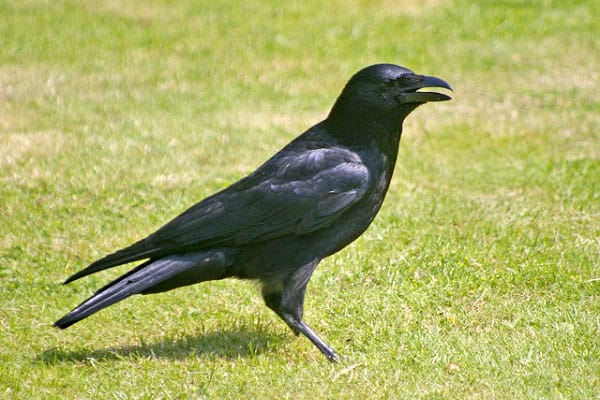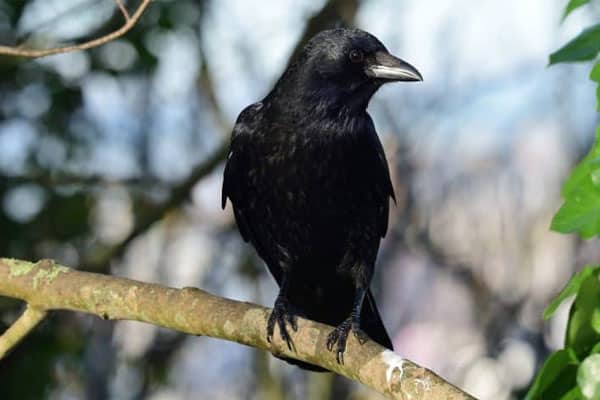Ever wondered, “What Do Crows Eat?” I’ve researched these omnivorous birds and discovered they enjoy a varied menu, from carrion to small mammals. Join me as we uncover the captivating dietary world of crows.
Main points:
- American crows are omnivorous birds, meaning they eat both plant and animal matter.
- Crows have a wide range of food sources, including nuts and seeds, carrion, eggs and nestlings, and small birds.
- They are opportunistic scavengers and play a vital role in cleaning up decaying organic matter in their ecosystem.
- Crows can also hunt small mammals and raid the nests of other birds for food.
- Feeding crows responsibly can be done by offering appropriate food items like peanuts and dried fruits, while avoiding harmful substances like salt.
The Omnivorous Nature of Crows
Crows, specifically the American crow, are fascinating birds with an omnivorous diet. This means they have the remarkable ability to consume both plant and animal matter. Their adaptability and wide-ranging food preferences make them highly successful in diverse environments.
As omnivores, crows have the capability to eat a variety of foods, allowing them to thrive in different habitats. This dietary flexibility is one of their key survival strategies, enabling them to make the most of available resources.

Crows have adapted to feed on various types of plant-based foods, including nuts and seeds. They can crack open walnuts, pecans, and other hard-shell nuts using their strong beaks. Additionally, crows are known to enjoy a range of fruits, such as chokecherries and dried cranberries.
While plant matter forms a significant part of their diet, crows are also opportunistic predators. They are capable hunters, targeting small mammals and birds when the opportunity arises. Their feeding patterns sometimes involve raiding the nests of other birds to consume eggs, nestlings, and even smaller birds.
“Crows, with their omnivorous nature, demonstrate remarkable adaptability and resourcefulness in their food choices. This flexibility enables them to thrive in various ecosystems, making them intelligent and fascinating creatures.”
The omnivorous nature of crows sets them apart from many other bird species. It allows them to take advantage of a wide array of food sources, increasing their chances of survival in different environments. The ability to switch between plant-based and animal-based foods gives them a competitive advantage, as they can exploit diverse food resources.
Food Sources for Crows
Crows are resourceful birds that rely on a diverse range of food sources to meet their nutritional needs. Their adaptable nature allows them to thrive in a variety of environments, from rural areas to urban landscapes.

Nuts and Seeds: Crows can eat a wide variety of nuts and seeds, including walnuts, pecans, and pistachios. These nutrient-rich foods provide essential fats and proteins for their diet.
Fruits and Berries: Crows have a fondness for fruits like chokecherries and dried cranberries. These natural treats offer a source of carbohydrates and vitamins.
Carrion: As scavengers, crows eagerly scavenge for carrion, including roadkill and small animals. This behavior not only ensures a readily accessible food source but also helps to keep the environment clean.
Nestlings and Eggs: Crows are opportunistic feeders and will raid the nests of other birds to consume eggs and nestlings. This behavior provides them with a valuable source of protein.
Small Birds and Songbirds: In their quest for sustenance, crows don’t hesitate to prey on smaller birds, including songbirds. These avian species become prey for crows due to their smaller size and vulnerability.
Small Mammals: Crows are known to feed on small mammals like shrews and rodents. This hunting behavior allows them to supplement their diet with additional sources of protein.
Urban Environments: In urban environments, crows have learned to adapt and find food in various forms. They may scavenge discarded human food items, such as french fries, and even prey on small mammals like rodents that are commonly found in cities.
Did you know?
Crows have been observed using tools to access hard-to-reach food items. Their intelligence and problem-solving abilities contribute to their success as adaptable foragers.
Crows as Scavengers
Crows are opportunistic scavengers, constantly on the lookout for their next meal. As scavengers, they have adapted to feed on a variety of food sources, including carrion. Carrion refers to the decaying flesh of dead animals, and it serves as an important food source for crows.
“Carrion makes up a significant part of a crow’s diet, providing them with protein and other nutrients necessary for their survival,” says Dr. Maria Rodriguez, an avian biologist at the National Wildlife Institute.
Being opportunist scavengers, crows play a crucial role in cleaning up the environment by consuming carrion and preventing the spread of disease. Their ability to efficiently remove decaying organic matter helps maintain a healthier ecosystem.
Crows are not the only scavengers in the animal kingdom. They are in direct competition with other carrion-feeders, such as vultures. However, crows’ adaptability and intelligence make them formidable scavengers, allowing them to locate even well-hidden carrion and outcompete other opportunistic scavengers.
Carrion Consumption and the Ecosystem
The consumption of carrion by crows helps in the decomposition process, speeding up the breakdown of organic matter and recycling nutrients back into the ecosystem. This reduces the risk of disease transmission and prevents the accumulation of rotting carcasses.
Furthermore, crows’ scavenging behavior contributes to the overall health and balance of the ecosystem. By consuming carrion, the population of potential disease vectors, such as flies and maggots, is kept in check. This helps reduce the transmission of diseases that can affect both wildlife and humans.
Competition and Adaptability
The scavenging behavior of crows puts them in direct competition with other scavengers, including vultures. While vultures are specialized carrion feeders, crows’ adaptability and versatility give them an edge in obtaining carrion resources.
Crows have been observed to scavenge on carrion in various environments, including urban areas, where they make use of roadkill and other available food sources. Their ability to thrive in diverse habitats and adapt to changing conditions makes them successful scavengers.
Overall, crows play a vital role as opportunist scavengers, consuming carrion and contributing to the overall health of the ecosystem. Their adaptability and intelligence make them valuable contributors to the ecological balance.
Hunting and Foraging Habits of Crows
While crows primarily scavenge for their food, they are also skilled hunters. These intelligent birds will seize the opportunity to feed on small mammals and birds when the chance arises. Their ability to adapt and exploit feeding opportunities in their environment is truly remarkable.
Crows are known to be opportunistic hunters, taking advantage of feeding patterns and raiding the nests of other birds for eggs and nestlings. This behavior allows them to diversify their diet and ensures they have a steady supply of food.
For crows, hunting and foraging are ingrained in their feeding patterns. They possess keen instincts that enable them to identify the best sources of food and capitalize on them. Whether it’s small mammals or birds to eat, crows are skilled at honing in on their prey and making the most of every feeding opportunity.
These resourceful birds have a knack for locating and exploiting various feeding opportunities. By raiding the nests of other birds, they can acquire important protein and fat sources like eggs and nestlings. This strategy allows them to supplement their scavenged diet and meet their nutritional needs.
“Crows are fantastic at finding and imitating the feeding behaviors of other birds. They have learned to identify the feeding patterns of their potential prey and use that knowledge to their advantage, ensuring they get a steady supply of food,” says Dr. Jane Miller, a renowned ornithologist.
In summary, while scavenging is the primary method of obtaining food for crows, they are also proficient hunters. They take advantage of feeding patterns, raid nests for eggs and nestlings, and seize every feeding opportunity available to them. These adaptable birds have honed their foraging skills to ensure their survival in diverse environments.
| Hunting and Foraging Habits of Crows | |
|---|---|
| Hunting Behaviors | Foraging Habits |
| Crows hunt small mammals and birds when given the opportunity | Crows take advantage of feeding patterns |
| They raid the nests of other birds for eggs and nestlings | Crows exploit various feeding opportunities |
| Crows have a diverse diet, scavenging and hunting for food | |
Feeding Crows and Tips for Attracting Them
If you want to attract crows to your backyard, we can provide them with food in a responsible manner. Crows like to eat a variety of foods, including peanuts, dried fruits, and unsalted nuts. When feeding wild crows, it’s essential to make sure they’re getting appropriate and safe food items. We need to avoid harmful substances like salt and create a balanced diet for these intelligent and captivating birds.
The Importance of Crows in the Ecosystem
Crows are not just intelligent birds; they also play a crucial role in maintaining the balance of our ecosystem. There are various crow species found across different habitats, and their populations can be impacted by factors such as habitat loss in urban environments.
One of the remarkable contributions of crows is their ability to help control the spread of diseases, including the West Nile virus. They achieve this by feeding on insects that have been infected with the virus, thereby reducing the potential transmission to humans and other animals.
However, crows themselves face challenges due to human activities. Pesticide use negatively impacts their food sources and overall health, posing a threat to their populations. To ensure the continued presence of these intelligent and fascinating birds, we must prioritize the preservation of their habitats and minimize the use of harmful pesticides in our environment.


Add comment